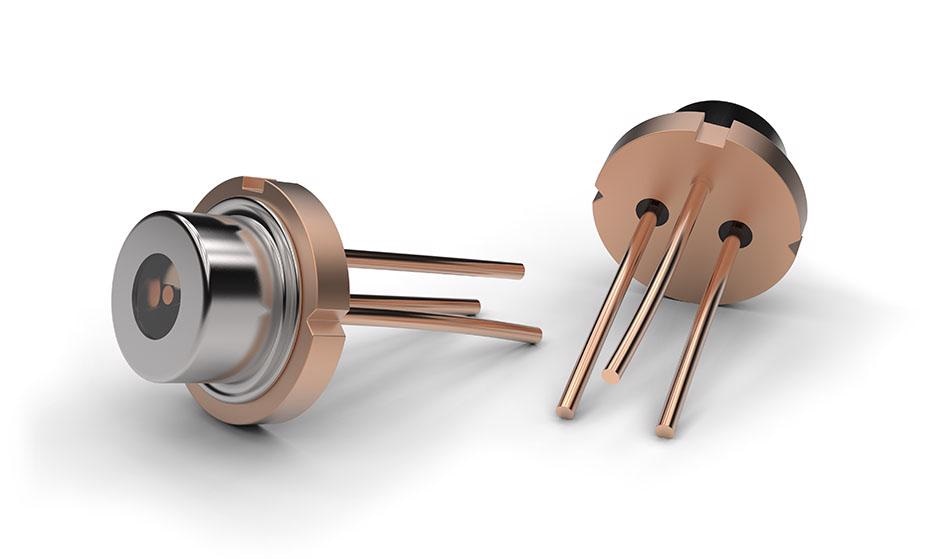
Peter Sobolev / Shutterstock
Semiconductor lasers are devices that use a similar process of light discharge as LEDs (light-emitting diodes). However, semiconductor lasers cause laser oscillation by stimulating an electric current to a semiconductor, creating a radiant output similar to a beam of light. Also known as laser diodes, semiconductor lasers are often used due to being cost-friendly and small in size. At a closer look, these lasers seem more like a contraption of several structures and nanometer scaled parts.
In order to produce light in a semiconductor laser, the mechanisms and laser system itself must be inverted. Lasers are high carrier density systems - they involve main-body exchange and interplay, as well as radiative recombination of electrons.
Design Breakdown of Semiconductor Lasers
A semiconductor laser has a simple three-tier breakdown; its medium is the junction of the forward-biased P-N diode between two metal contacts. The surrounding metal parts merge the P-N material to the DC power supply, while the junction light is emitted, or injected, when electrons pass from N to P-type, therefore spurring another name for the device: Injection Lasers.
A minimum current density is required for laser production. The laser output functions once the minimum current density is achieved, then the current density across the junction area will increase and push the output forward.
The semiconductor laser’s reflection originates at the cleaved ends of the semiconductor chip, therefore eliminating mirrors, which is typically needed for other lasers to produce lasing.
Advantages of Semiconductor Lasers
The advantages of semiconductor lasers range from their energy efficiency to their economical pricing. These lasers consume less power than typical lighting techniques, as well as employing long term operational lasers. Semiconductor lasers are also capable of generating passive cooling techniques in their design - these lasers are elaborately made at the nanometer scale. Although the device seems complex at a small scale, for everyday use it is very simple to operate and as said before, runs cheaply.
Semiconductor lasers fuel many advantages; their long life, stark single color, adjustable, and an endless beam of light, add to the device’s economical and user-friendly nature. Unlike other lasers, mirrors are not necessary to produce semiconductor laser beams.
Disadvantages of Semiconductor Lasers
Despite the many advantages of semiconductor lasers, there are still drawbacks to the device.
Temperature affects the laser’s output. An increase in junction temperature can cause damaging effects on the laser’s operating features, as well as limit the efficiency of a semiconductor laser. Threshold current, diode reliability, power magnitude, and light output are all factors that can be deformed by temperature in a semiconductor laser.
Semiconductor lasers also produce a low power - despite their longevity and brightness, this is still a downside to the device. Other lasers have more control over their light beams in comparison to the semiconductor laser - this is also viewed as an operational flaw because the device’s divergence is less controllable.
The cooling requirement is seen as mostly an advantage - semiconductors play a vital role in current and future quantum computers and ultrasensitive sensors - but this can also be problematic in a few situations.
Conclusion
The semiconductor laser is a small and practical device, its compact size allows it to be versatile and suitable for multiple applications in gadgets, computers, and tools. Although the device is known for its simple construction, it is structured in multiple layers.
Semiconductor lasers are also known as Gallium Arsenide Lasers because of material gallium Arsenide, which is the material used inside the device. The simple design of the laser is modeled as a junction between two metal contacts, with a laser output on the side.
Although semiconductor lasers do not necessarily produce the ideal beam of light that other lasers can, their compact size and operational efficiency make them beneficial devices.
Sources
Disclaimer: The views expressed here are those of the author expressed in their private capacity and do not necessarily represent the views of AZoM.com Limited T/A AZoNetwork the owner and operator of this website. This disclaimer forms part of the Terms and conditions of use of this website.